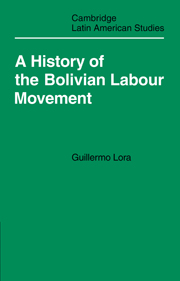Book contents
- Frontmatter
- Contents
- Editor's introduction
- Book 1 Protection versus free trade
- Book 2 Mineowners, artisans and Utopian socialists
- Book 3 Workers and the Liberal Party 1900–20
- Book 4 The nineteen-twenties
- Book 5 From the Chaco defeat to the Catavi massacre 1932–42
- Book 6 The workers become revolutionary
- Book 7 The rise and fall of the Central Obrera Boliviana
- Book 8 The military versus the unions
- Notes
- Editor's suggested reading
- Index
Editor's introduction
Published online by Cambridge University Press: 07 September 2010
- Frontmatter
- Contents
- Editor's introduction
- Book 1 Protection versus free trade
- Book 2 Mineowners, artisans and Utopian socialists
- Book 3 Workers and the Liberal Party 1900–20
- Book 4 The nineteen-twenties
- Book 5 From the Chaco defeat to the Catavi massacre 1932–42
- Book 6 The workers become revolutionary
- Book 7 The rise and fall of the Central Obrera Boliviana
- Book 8 The military versus the unions
- Notes
- Editor's suggested reading
- Index
Summary
An independent Bolivia has been in existence for a century and a half, although the present-day frontiers are much more recent. Throughout that period there have been two main economic activities: very-low-productivity agriculture for local consumption, and relatively-high-productivity extractive industries for remote world markets. Until the eradication of malaria about 30 years ago almost the entire labour force was concentrated on the western third of the present-day territory, scattered across the lunar landscapes of the Altiplano or huddled in the few overcrowded temperate valley basins. Whether engaged in agriculture or mining, the living conditions of Bolivian workers were miserable, and even in the 1960s average income per capita was reckoned to be lower than in any other South American republic. (This calculation may no longer hold true since 1974, when oil and natural gas for the first time overtook minerals as the chief source of Bolivia's foreign exchange, but although average income may now be rising fast, the benefits are being very unevenly distributed.)
So miserable were the health and nutritional conditions of most Bolivians that the natural population-growth rate remained low; and so remote and inaccessible was the republic from world markets that virtually no immigrants could be attracted in. Quite the contrary, in the twentieth century Bolivian workers have migrated in tens of thousands to the nitrate mines of northern Chile, the sugar harvests of northern Argentina, and more recently to the factories of Córdoba and the construction sites of Buenos Aires.
- Type
- Chapter
- Information
- A History of the Bolivian Labour Movement 1848–1971 , pp. vii - xPublisher: Cambridge University PressPrint publication year: 1977

